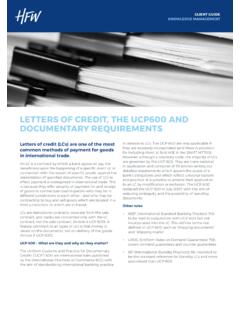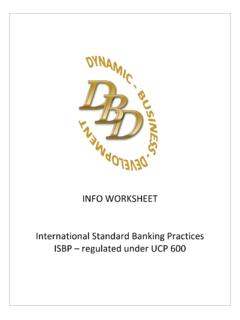Transcription of Understanding the URDG 758 - fpsc.com
1 Understanding the URDG 758By John BaranelloDirector, Trade and Risk ServicesGlobal Transaction Banking The Uniform Rules for Demand Guarantees, 2010 Revision, International Chamber of Commerce Publication No. 758 (the "URDG"), became effective on July 1, to unify independent guarantee practice, this revised set of rules fordemand guarantees and counter-guarantees replaces International Chamber ofCommerce Publication , which was issued in 1992 but not extensively used in the new Publication 758 is fashioned after the widely successful Uniform Customsand Practice for Documentary Credits (UCP) 600. Similar to ucp600 and InternationalStandby Practices 98 (ISP98), URDG 758 is not "law." It merely sets out the roles andresponsibilities of all parties at each key stage of the life cycle of a demand guaranteeand reflects "best practice" in the guarantee three years of working on these new rules, the ICC has produced a publicationthat is comprehensive, innovative and concise.
2 Banks in the US, if they choose to doso, now have another offering in their product set that their clients may opt to usewhen considering how to best support their cross-border Some Key ProvisionsArticle 7of URDG 758 is similar to ISP98 Rule , ucp600 article 14(h) andNYUCC 5-108(g), in that non-documentary conditions are to be , URDG adds an exception that non-documentary conditions are notto bedisregarded to the extent that information in any required documents conflicts withsuch conditions. This URDG rule can make it tricky to know when these conditionsare met and compliance is necessary. To minimize errors, banks may want toprovide extra training to those examining these article 14(b)permits the presenter to provide the required information for acomplying demand in a piecemeal fashion if it records this in its partial presentationand if the presentation is completed before the guarantee expires.
3 This effectivelyshifts the burden of storing and caring for documentation until a demand is completefrom the presenter to the guarantor. Under ISP98, ucp600 and the NYUCC, a bankis permitted to return incomplete, non-complying documents to the URDG article 15requirement for presentation of a default statement, even if not mentioned in the guarantee, is a potential trap for both beneficiaries andguarantors. A beneficiary that is unaware of this requirement may fail to present this statement and be unable to correct this if the guarantee is to expire shortly. A guarantor that fails to request the statement may jeopardize its right toreimbursement. Beneficiaries and guarantors may protect themselves by using the article 15(c) option to exclude any requirement for the presentation of a defaultstatement under article 15(a) or (b). Banks may also want to include protectiveprovisions in their reimbursement article 24provides that notice of dishonor must be sent "without delay" and not later than the close of the fifth business day.
4 However, "without delay" is not explicitly defined, and it could be argued that this means just one or two ISP98, ucp600 nor the NYUCC requires that notice be given "without delay"(as opposed to within a "reasonable time" or "within a specified period of time").ISP98 Rule (a)(i) provides a "safe harbor" for issuers notice within threebusiness days after the day of presentation is deemed to be not unreasonable andtherefore does not trigger the preclusion penalty. Banks may protect themselves from this URDG risk by including appropriate provisions in their guarantees orreimbursement article 35has no counterpart in ISP98 or ucp600 . It specifies an "exclusiveplace" for the resolution of disputes something that may work well where there is a demand guarantee but no counter-guarantee. However, where there are both, the"exclusive place" can be different for the guarantor than for the counter-guarantor(likely, as they will often be located in different countries).
5 This exposes them to therisk of inconsistent judgments ( , a court in Country A may hold that the guarantoris obligated to pay under the demand guarantee, but a court in Country B may holdthat the guarantor is not entitled to be paid under the counter-guarantee). The partiesmay wish instead to agree on exclusive jurisdiction in a single jurisdiction for bothguarantees. NYUCC 5-116(e) permits great freedom in selecting the jurisdiction for disputes under documentary 's Independent RoleURDG 758 is being actively promoted and marketed by the ICC and has beenofficially translated into 16 languages. It clearly recognizes the guarantor'sindependent role, as detailed in URDG article 5, which points out that a guarantee is independent of the underlying relationship and application, and in article 6, whichstates that guarantors deal with documents and not with the goods, services orperformance to which the documents may 758 also recognizes the guarantor's potential role of being in the middle of adispute between the beneficiary and the instructing party by requiring the guarantor to,without delay, notify the instructing party of any demand to extend the guarantee(Articles 16 and 23).
6 URDG 758 also offers a model guarantee and counter-guaranteefor use, which will further level the playing field and help avoid any 758 has been endorsed by the World Bank, the International Federation ofConsulting Engineers (FIDIC), the Organization for Harmonization of Business Law inAfrica (OHADA), the UN Commission for International Trade Law and that URDG 458 reportedly governs over $14 trillion in trade, there aremany new opportunities that URDG 758 offers the trade finance community throughmore comprehensive, stronger and clearer rules for demand guarantees.

